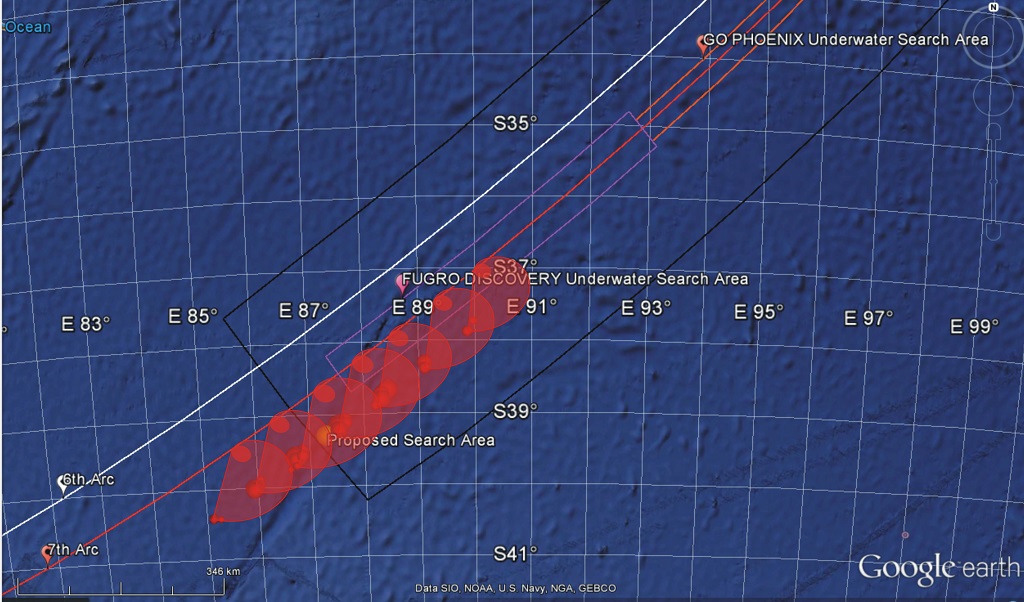Octavian Thor Pleter and Cristian Emil Constantinescu, and Barna Istvan Jakab, University Politehnica of Bucharest, 060042 Bucharest, Romania
Abstract: In the aftermath of the disappearance of the Malaysian 370 (MH370) flight in March 2014, new positioning methods were employed to establish the search area. In the absence of all other positioning technologies (Transponder, Radio communications, Radar), these innovative methods are based on the handshake signals between an INMARSAT satellite and the satellite transceiver on board the aircraft. The log of these signals was made public in order for the scientific community to engage in solving the mystery of the MH370 trajectory. The log indicates the delay between the interrogation and response signals, as well as the relative velocity indications, based on the shift of the carrier frequency due to the Doppler-Fizeau effect. This paper puts forward an original, independent and accurate positioning method and allows the calculation of the MH370 trajectory considering the wind vector field that day, the accurate satellite orbit and an accurate model of the Earth (the WGS-84 ellipsoid). The results were compared to other results published, indicating a different final position of the aircraft from the locations of the published search area.
Download full article here.
The article won the Richey Medal 2017 of the Royal Institute of Navigation, London.
Anunț privind desfășurarea concursului de ocupare a funcțiilor de DECAN 2024 – 2029
<< Anunț privind desfășurarea concursului de ocupare a funcțiilor de DECAN din cadrul facultăților Universității Naționale de Știință și Tehnologie POLITEHNICA București pentru mandatul 2024 - 2029 >> << Metodologie privind organizarea și...
Selecție mobilități studenți, Granturi SEE Universitatea din Islanda decembrie 2023
În cadrul Programului de Educaţie, Burse, Ucenicie şi Antreprenoriatul Tinerilor (ESAYEP), finanţat prin Granturile SEE - Mecanismul Financiar 2014-2021, se organizează selecția participanților pentru 6 mobilități studențești pentru anul universitar 2023-2024: Tip...
Selecție mobilități cadre didactice, Granturi SEE Universitatea din Islanda ianuarie 2024
În cadrul Programului de Educaţie, Burse, Ucenicie şi Antreprenoriatul Tinerilor (ESAYEP), finanţat prin Granturile SEE - Mecanismul Financiar 2014-2021, se organizează selecția participanților pentru 2 Mobilități de formare pentru anul universitar 2023-2024: „Staff...
Adresa AACR aprobare credite module PART 66 FIA
<< Adresa AACR aprobare credite module PART 66 FIA >> A fost emis și aprobat de către AACR, Raportul de Credite nr. 22313 din 29.06.2023 prin care se aprobă acordarea de credite pentru examinare absolvenților UPB-FIA, conform solicitării din scrisoarea...
Rezultatele deosebite ale studenților F.I.A. la Concursul Profesional Studențesc „Andrei IOACHIMESCU” la disciplina Mecanică Tehnică, 6 mai 2023
Va informam ca in ziua de 6 mai 2023, Departamentul de Mecanica din Facultatea de Ingineria Sistemelor Biotehnice, Universitatea Politehnica din Bucuresti, a organizat faza locala a Concursului Profesional Studentesc "Andrei IOACHIMESCU" la disciplina Mecanica...
Concurs pentru postul de director Departamentul de Științe Aerospațiale ”Elie Carafoli”
În conformitate cu prevederile Regulamentului privind organizarea și desfășurarea alegerilor din UPB în termen de 3 luni de la apariția unui loc vacant de membru al Consiliului facultății, Consiliului departamentului, Senat etc. se vor organiza alegeri parțiale....
Metodologia privind organizarea și desfășurarea taberelor studențești 2023
Casa de Cultură a Studenților din București, instituție publică subordonată Ministerului Familiei, Tineretului și Egalității de Șanse vă transmite va pune la dispozitie documentația aferentă și metodologia privind organizarea și desfășurarea taberelor studențești 2023...
Testare lingvistica British Council – UPB, gratuit pentru studentii de anul IV licenta si anul II master
Începând cu acest an academic, Universitatea POLITEHNICA din București în parteneriat cu British Council oferă studenților de anul IV licenta si anul II master, certificate lingvistice în mod gratuit. Pentru acest semestru universitar, testele disponibile sunt:...
Concurs ocupare posturi didactice si de cercetare vacante pe perioada nedeterminata semestrul II, anul universitar 2022-2023 GIDI (MO,III,Nr. 152 / 24.04.2023)
Departament [Domeniu Post] Poz. Stat Func Func Did Probe concurs Programare [ziua / ora / sala] Grafică Inginerească și Design Industrial [Inginerie Aerospațială] 28 As. Proba scrisă: Susținere in prezenta comisiei Joi 29 iun / 8:00 / BN 328 Proba orală :...
Concurs ocupare posturi didactice si de cercetare vacante pe perioada nedeterminata semestrul II, anul universitar 2022-2023 ISAMA (MO,III,Nr. 152 / 24.04.2023)
Departament [Domeniu Post] Poz. Stat Func Func Did Probe concurs Programare [ziua / ora / sala] Ingineria Sistemelor Aeronautice si Management Aeronautic “Nicolae Tipei” [Inginerie Aerospațială] 4 Conf. Susținere in prezenta comisiei: Prezentarea...


0 Comentarii